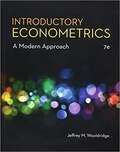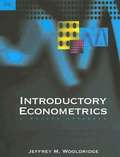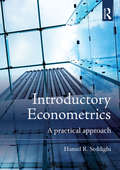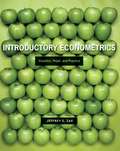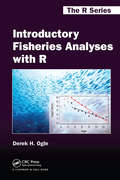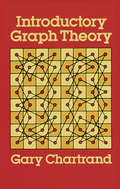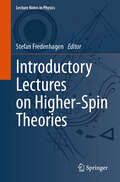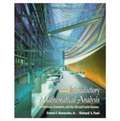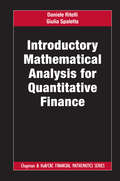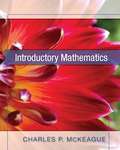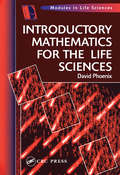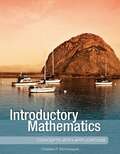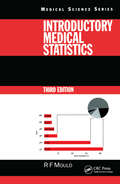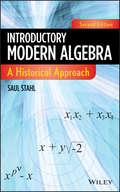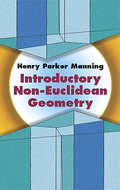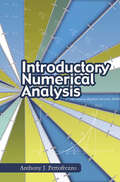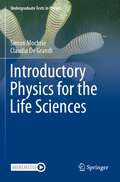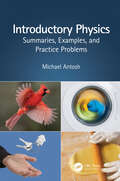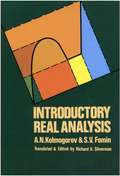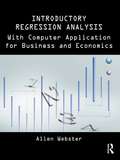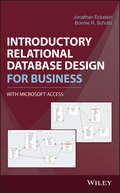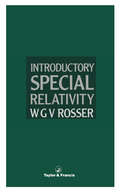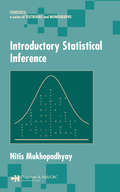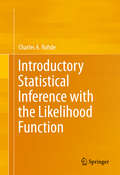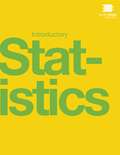- Table View
- List View
Introductory Econometrics: A Modern Approach (Mindtap Course List Series)
by Jeffrey M. WooldridgeGain an understanding of how econometrics can answer today's questions in business, policy evaluation and forecasting with Wooldridge's INTRODUCTORY ECONOMETRICS: A MODERN APPROACH, 7E. Unlike traditional texts, this book's practical, yet professional, approach demonstrates how econometrics has moved beyond a set of abstract tools to become genuinely useful for answering questions across a variety of disciplines. The author has organized the book's presentation around the type of data being analyzed with a systematic approach that only introduces assumptions as they are needed. This makes the material easier to understand and, ultimately, leads to better econometric practices. Packed with relevant applications, the text incorporates more than 100 data sets in different formats. Updates introduce the latest developments in the field, including the recent advances in the so-called 'causal effects' or 'treatment effects,' to provide a complete understanding of the impact and importance of econometrics today.
Introductory Econometrics: A Modern Approach (Third Edition)
by Jeffrey M. WooldridgeThe modern approach of this text recognizes that econometrics has moved from a specialized mathematical description of economics to an applied interpretation based on empirical research techniques. It bridges the gap between the mechanics of econometrics and modern applications of econometrics by employing a systematic approach motivated by the major problems facing applied researchers today. Throughout the text, the emphasis on examples gives a concrete reality to economic relationships and allows treatment of interesting policy questions in a realistic and accessible framework.
Introductory Econometrics: A Practical Approach
by Hamid SeddighiThis book constitutes the first serious attempt to explain the basics of econometrics and its applications in the clearest and simplest manner possible. Recognising the fact that a good level of mathematics is no longer a necessary prerequisite for economics/financial economics undergraduate and postgraduate programmes, it introduces this key subdivision of economics to an audience who might otherwise have been deterred by its complex nature.
Introductory Econometrics: Intuition, Proof, and Practice
by Jeffrey ZaxIntroductory Econometrics: Intuition, Proof, and Practice attempts to distill econometrics into a form that preserves its essence, but that is acceptable—and even appealing—to the student's intellectual palate. This book insists on rigor when it is essential, but it emphasizes intuition and seizes upon entertainment wherever possible. Introductory Econometrics is motivated by three beliefs. First, students are, perhaps despite themselves, interested in questions that only econometrics can answer. Second, through these answers, they can come to understand, appreciate, and even enjoy the enterprise of econometrics. Third, this text, which presents select innovations in presentation and practice, can provoke readers' interest and encourage the responsible and insightful application of econometric techniques. In particular, author Jeffrey S. Zax gives readers many opportunities to practice proofs—which are challenging, but which he has found to improve student comprehension. Learning from proofs gives readers an organic understanding of the message behind the numbers, a message that will benefit them as they come across statistics in their daily lives. An ideal core text for foundational econometrics courses, this book is appropriate for any student with a solid understanding of basic algebra—and a willingness to use that tool to investigate complicated issues.
Introductory Fisheries Analyses with R (Chapman & Hall/CRC The R Series #32)
by Derek H. OgleA How-To Guide for Conducting Common Fisheries-Related Analyses in R Introductory Fisheries Analyses with R provides detailed instructions on performing basic fisheries stock assessment analyses in the R environment. Accessible to practicing fisheries scientists as well as advanced undergraduate and graduate students, the book demonstrates the flexibility and power of R, offers insight into the reproducibility of script-based analyses, and shows how the use of R leads to more efficient and productive work in fisheries science. The first three chapters present a minimal introduction to the R environment that builds a foundation for the fisheries-specific analyses in the remainder of the book. These chapters help you become familiar with R for basic fisheries analyses and graphics. Subsequent chapters focus on methods to analyze age comparisons, age-length keys, size structure, weight-length relationships, condition, abundance (from capture-recapture and depletion data), mortality rates, individual growth, and the stock-recruit relationship. The fundamental statistical methods of linear regression, analysis of variance (ANOVA), and nonlinear regression are demonstrated within the contexts of these common fisheries analyses. For each analysis, the author completely explains the R functions and provides sufficient background information so that you can confidently implement each method. Web Resource The author’s website at http://derekogle.com/IFAR/ includes the data files and R code for each chapter, enabling you to reproduce the results in the book as well as create your own scripts. The site also offers supplemental code for more advanced analyses and practice exercises for every chapter.
Introductory Graph Theory
by Gary ChartrandGraph theory is used today in the physical sciences, social sciences, computer science, and other areas. Introductory Graph Theory presents a nontechnical introduction to this exciting field in a clear, lively, and informative style. Author Gary Chartrand covers the important elementary topics of graph theory and its applications. In addition, he presents a large variety of proofs designed to strengthen mathematical techniques and offers challenging opportunities to have fun with mathematics. Ten major topics -- profusely illustrated -- include: Mathematical Models, Elementary Concepts of Graph Theory, Transportation Problems, Connection Problems, Party Problems, Digraphs and Mathematical Models, Games and Puzzles, Graphs and Social Psychology, Planar Graphs and Coloring Problems, and Graphs and Other Mathematics. A useful Appendix covers Sets, Relations, Functions, and Proofs, and a section devoted to exercises -- with answers, hints, and solutions -- is especially valuable to anyone encountering graph theory for the first time. Undergraduate mathematics students at every level, puzzlists, and mathematical hobbyists will find well-organized coverage of the fundamentals of graph theory in this highly readable and thoroughly enjoyable book.
Introductory Lectures on Higher-Spin Theories (Lecture Notes in Physics #1028)
by Stefan FredenhagenThe book offers a pedagogical introduction to higher-spin gauge theories. These theories build upon fundamental gauge theories that are crucial for understanding core interactions. Electromagnetism and nuclear forces are associated with gauge fields of spin 1, while gravity can be conceptualized as a gauge theory of spin 2. This prompts the intriguing inquiry: do higher-spin gauge theories exist? Such theories would extend gravity, incorporating massless gauge fields of spins higher than two. They appear to bear connections to string theory and offer a captivating framework for exploring gravity and aspects of quantum gravity. The book initiates with a primer offering a comprehensive discussion on higher spins, delving into the challenges of establishing coherent interactions. It then explores methodologies to surmount these challenges within three-dimensional space-time. Furthermore, it investigates the emergence of asymptotic symmetry algebras, establishing links to a holographic dual conformal theory. The final chapter introduces Vasiliev’s approach to higher-spin gauge theory in four dimensions. Designed for advanced students and young researchers in theoretical physics and mathematical physics, the book aims to elucidate fundamental ideas, concepts, and tools underpinning higher-spin gauge theories. The inclusion of numerous exercises complements and illustrates the content, preparing readers for engagement with the subject's original literature and ongoing developments. To fully engage with the book's arguments, a prerequisite understanding of field theories and conventional gauge theories, including gravity, is assumed.
Introductory Mathematical Analysis for Business, Economics, and the Life and Social Sciences (Ninth Edition)
by Ernest F. Haeussler Richard S. PaulThis ninth edition of Introductory Mathematical Analysis continues to provide a mathematical foundation for students in business, economics, and the life and social sciences. It begins with noncalculus topics such as equations, functions, matrix algebra, linear programming, mathematics of finance, and probability. Then it progresses through both single-variable and multivariable calculus, including continuous random variables.
Introductory Mathematical Analysis for Quantitative Finance (Chapman and Hall/CRC Financial Mathematics Series)
by Daniele Ritelli Giulia SpalettaIntroductory Mathematical Analysis for Quantitative Finance is a textbook designed to enable students with little knowledge of mathematical analysis to fully engage with modern quantitative finance. A basic understanding of dimensional Calculus and Linear Algebra is assumed. The exposition of the topics is as concise as possible, since the chapters are intended to represent a preliminary contact with the mathematical concepts used in Quantitative Finance. The aim is that this book can be used as a basis for an intensive one-semester course. Features: Written with applications in mind, and maintaining mathematical rigor. Suitable for undergraduate or master's level students with an Economics or Management background. Complemented with various solved examples and exercises, to support the understanding of the subject.
Introductory Mathematics
by Charles P. Mckeague McKeagueThis textbook provides students with a solid foundation in basic mathematics, and an excellent preparation for algebra. The format, examples, and problems in this book have been refined through more than 20 years of classroom testing. As with all McKeague titles, his emphasis on study skills and his positive tone toward success are reflected in the presentation. Published by XYZ textbooks.
Introductory Mathematics for the Life Sciences (Modules In Life Science Ser.)
by David PhoenixIntroductory Mathematics for the Life Sciences offers a straightforward introduction to the mathematical principles needed for studies in the life sciences. Starting with the basics of numbers, fractions, ratios, and percentages, the author explains progressively more sophisticated concepts, from algebra, measurement, and scientific notation through the linear, power, exponential, and logarithmic functions to introductory statistics. Worked examples illustrate concepts, applications, and interpretations, and exercises at the end of each chapter help readers apply and practice the skills they develop. Answers to the exercises are posted at the end of the text.
Introductory Mathematics: Concepts with Applications
by Charles P. McKeague"This textbook provides students with a solid foundation in basic mathematics, and an excellent preparation for algebra. The format, examples, and problems in this book have been refined through more than 20 years of classroom testing. As with all McKeague titles, his emphasis on study skills and his positive tone toward success are reflected in the presentation."
Introductory Medical Statistics, 3rd edition
by Richard F. MouldIntroductory Medical Statistics, now in its third edition, is an introductory textbook on basic statistical techniques. It is written for physicians, surgeons, radiation oncologists, medical physicists, radiographers, hospital administrators, medical statisticians in training, biochemists, and other professionals allied to medicine. It is suitable
Introductory Modern Algebra
by Saul StahlPraise for the First Edition"Stahl offers the solvability of equations from the historical point of view...one of the best books available to support a one-semester introduction to abstract algebra."--CHOICEIntroductory Modern Algebra: A Historical Approach, Second Edition presents the evolution of algebra and provides readers with the opportunity to view modern algebra as a consistent movement from concrete problems to abstract principles. With a few pertinent excerpts from the writings of some of the greatest mathematicians, the Second Edition uniquely facilitates the understanding of pivotal algebraic ideas.The author provides a clear, precise, and accessible introduction to modern algebra and also helps to develop a more immediate and well-grounded understanding of how equations lead to permutation groups and what those groups can inform us about such diverse items as multivariate functions and the 15-puzzle. Featuring new sections on topics such as group homomorphisms, the RSA algorithm, complex conjugation, the factorization of real polynomials, and the fundamental theorem of algebra, the Second Edition also includes:An in-depth explanation of the principles and practices of modern algebra in terms of the historical development from the Renaissance solution of the cubic equation to Dedekind's idealsHistorical discussions integrated with the development of modern and abstract algebra in addition to many new explicit statements of theorems, definitions, and terminologyA new appendix on logic and proofs, sets, functions, and equivalence relationsOver 1,000 new examples and multi-level exercises at the end of each section and chapter as well as updated chapter summariesIntroductory Modern Algebra: A Historical Approach, Second Edition is an excellent textbook for upper-undergraduate courses in modern and abstract algebra.
Introductory Non-Euclidean Geometry (Dover Books on Mathematics)
by Henry Parker ManningThis fine and versatile introduction to non-Euclidean geometry is appropriate for both high-school and college classes. Its first two-thirds requires just a familiarity with plane and solid geometry and trigonometry, and calculus is employed only in the final part. It begins with the theorems common to Euclidean and non-Euclidean geometry, and then it addresses the specific differences that constitute elliptic and hyperbolic geometry. Major topics include hyperbolic geometry, single elliptic geometry, and analytic non-Euclidean geometry. 1901 edition.
Introductory Numerical Analysis
by Anthony J. PettofrezzoGeared toward undergraduate mathematics majors, engineering students, and future high school mathematics teachers, this text offers an understanding of the principles involved in numerical analysis. Its main theme is interpolation from the standpoint of finite differences, least squares theory, and harmonic analysis. Additional considerations include the numerical solutions of ordinary differential equations and approximations through Fourier series. Discussions of the relationships between the calculus of finite differences and the calculus of infinitesimals will prove especially important to future teachers of mathematics.More than seventy worked-out illustrative examples are featured; some include solutions by different methods, showing the relative merits of a variety of approaches. Over 280 multipart exercises range from drill problems to those requiring some degree of ingenuity on the part of the student. Answers are provided to problems with numerical solutions. The only prerequisites are a grasp of differential and integral calculus and some familiarity with determinants. An appendix containing definitions and several theorems from elementary determinant theory is included.
Introductory Physics for the Life Sciences (Undergraduate Texts in Physics)
by Simon Mochrie Claudia De GrandiThis classroom-tested textbook is an innovative, comprehensive, and forward-looking introductory undergraduate physics course. While it clearly explains physical principles and equips the student with a full range of quantitative tools and methods, the material is firmly grounded in biological relevance and is brought to life with plenty of biological examples throughout.It is designed to be a self-contained text for a two-semester sequence of introductory physics for biology and premedical students, covering kinematics and Newton’s laws, energy, probability, diffusion, rates of change, statistical mechanics, fluids, vibrations, waves, electromagnetism, and optics. Each chapter begins with learning goals, and concludes with a summary of core competencies, allowing for seamless incorporation into the classroom. In addition, each chapter is replete with a wide selection of creative and often surprising examples, activities, computational tasks, and exercises, many of which are inspired by current research topics, making cutting-edge biological physics accessible to the student.
Introductory Physics: Summaries, Examples, and Practice Problems
by Michael AntoshPhysics describes how motion works in everyday life. Clothes washers and rolling pins are undergoing rotational motion. A flying bird uses forces. Tossing a set of keys involves equations that describe motion (kinematics). Two people bumping into each other while cooking in a kitchen involves linear momentum. This textbook covers topics related to units, kinematics, forces, energy, momentum, circular and rotational motion, Newton’s general equation for gravity, and simple harmonic motion (things that go back and forth). A math review is also included, with a focus on algebra and trigonometry. The goal of this textbook is to present a clear introduction to these topics, in small pieces, with examples that readers can relate to. Each topic comes with a short summary, a fully solved example, and practice problems. Full solutions are included for over 400 problems. This book is a very useful study guide for students in introductory physics courses, including high school and college students in an algebra-based introductory physics course and even students in an introductory calculus-level course. It can also be used as a standalone textbook in courses where derivations are not emphasized.
Introductory Real Analysis
by Richard A. Silverman S. V. Fomin A. N. KolmogorovThis volume in Richard Silverman's exceptional series of translations of Russian works in the mathematical science is a comprehensive, elementary introduction to real and functional analysis by two faculty members from Moscow University. It is self-contained, evenly paced, eminently readable, and readily accessible to those with adequate preparation in advanced calculus.The first four chapters present basic concepts and introductory principles in set theory, metric spaces, topological spaces, and linear spaces. The next two chapters consider linear functionals and linear operators, with detailed discussions of continuous linear functionals, the conjugate space, the weak topology and weak convergence, generalized functions, basic concepts of linear operators, inverse and adjoint operators, and completely continuous operators. The final four chapters cover measure, integration, differentiation, and more on integration. Special attention is here given to the Lebesque integral, Fubini's theorem, and the Stieltjes integral. Each individual section -- there are 37 in all -- is equipped with a problem set, making a total of some 350 problems, all carefully selected and matched.With these problems and the clear exposition, this book is useful for self-study or for the classroom -- it is basic one-year course in real analysis. Dr. Silverman is a former member of the Institute of Mathematical Sciences of New York University and the Lincoln Library of M.I.T. Along with his translation, he has revised the text with numerous pedagogical and mathematical improvements and restyled the language so that it is even more readable.
Introductory Regression Analysis: with Computer Application for Business and Economics
by Allen WebsterRegression analysis is arguably the single most powerful and widely applicable tool in any effective examination of common business issues. Every day, decision-makers face problems that require constructive actions with significant consequences, and regression procedures can prove a meaningful and valuable asset in the decision-making process. This text is designed to help students achieve a full understanding of regression and the many ways it can be used. Taking into consideration current statistical technology, Introductory Regression Analysis focuses on the use and interpretation of software, while also demonstrating the logic, reasoning, and calculations that lie behind any statistical analysis. Furthermore, the text emphasizes the application of regression tools to real-life business concerns. This multilayered, yet pragmatic approach fully equips students to derive the benefit and meaning of a regression analysis. This text is designed to serve in a second undergraduate course in statistics, focusing on regression and its component features. The material presented in this text will build from a foundation of the principles of data analysis. Although previous exposure to statistical concepts would prove helpful, all the material needed for an examination of regression analysis is presented here in a clear and complete form.
Introductory Relational Database Design for Business, with Microsoft Access
by Jonathan Eckstein Bonnie R. SchultzA hands-on beginner’s guide to designing relational databases and managing data using Microsoft Access Relational databases represent one of the most enduring and pervasive forms of information technology. Yet most texts covering relational database design assume an extensive, sophisticated computer science background. There are texts on relational database software tools like Microsoft Access that assume less background, but they focus primarily on details of the user interface, with inadequate coverage of the underlying design issues of how to structure databases. Growing out of Professor Jonathan Eckstein’s twenty years’ experience teaching courses on management information systems (MIS) at Rutgers Business School, this book fills this gap in the literature by providing a rigorous introduction to relational databases for readers without prior computer science or programming experience. Relational Database Design for Business, with Microsoft Access helps readers to quickly develop a thorough, practical understanding of relational database design. It takes a step-by-step, real-world approach, using application examples from business and finance every step the way. As a result, readers learn to think concretely about database design and how to address issues that commonly arise when developing and manipulating relational databases. By the time they finish the final chapter, students will have the knowledge and skills needed to build relational databases with dozens of tables. They will also be able to build complete Microsoft Access applications around such databases. This text: Takes a hands-on approach using numerous real-world examples drawn from the worlds of business, finance, and more Gets readers up and running, fast, with the skills they need to use and develop relational databases with Microsoft Access Moves swiftly from conceptual fundamentals to advanced design techniques Leads readers step-by-step through data management and design, relational database theory, multiple tables and the possible relationships between them, Microsoft Access features such as forms and navigation, formulating queries in SQL, and normalization Introductory Relational Database Design for Business, with Microsoft Access is the definitive guide for undergraduate and graduate students in business, finance, and data analysis without prior experience in database design. While Microsoft Access is its primary “hands-on” learning vehicle, most of the skills in this text are transferrable to other relational database software such as MySQL.
Introductory Special Relativity
by W G RosserA comprehensive introduction to special relativity for undergraduate study. Based on the highly regarded textbook Relativity and High Energy Physics. Includes numerous worked examples. Now thoroughly revised and expanded. Fully meets the needs of first year physics undergraduates.
Introductory Statistical Inference
by Nitis MukhopadhyayIntroductory Statistical Inference develops the concepts and intricacies of statistical inference. With a review of probability concepts, this book discusses topics such as sufficiency, ancillarity, point estimation, minimum variance estimation, confidence intervals, multiple comparisons, and large-sample inference. It introduces techniques of two-stage sampling, fitting a straight line to data, tests of hypotheses, nonparametric methods, and the bootstrap method. It also features worked examples of statistical principles as well as exercises with hints. This text is suited for courses in probability and statistical inference at the upper-level undergraduate and graduate levels.
Introductory Statistical Inference with the Likelihood Function
by Charles A. RohdeThis textbook covers the fundamentals of statistical inference and statistical theory including Bayesian and frequentist approaches and methodology possible without excessive emphasis on the underlying mathematics. This book is about some of the basic principles of statistics that are necessary to understand and evaluate methods for analyzing complex data sets. The likelihood function is used for pure likelihood inference throughout the book. There is also coverage of severity and finite population sampling. The material was developed from an introductory statistical theory course taught by the author at the Johns Hopkins University's Department of Biostatistics. Students and instructors in public health programs will benefit from the likelihood modeling approach that is used throughout the text. This will also appeal to epidemiologists and psychometricians. After a brief introduction, there are chapters on estimation, hypothesis testing, and maximum likelihood modeling. The book concludes with sections on Bayesian computation and inference. An appendix contains unique coverage of the interpretation of probability, and coverage of probability and mathematical concepts.
Introductory Statistics
by Barbara Illowsky Susan DeanIntroductory Statistics is designed for the one-semester, introduction to statistics course and is geared toward students majoring in fields other than math or engineering. This text assumes students have been exposed to intermediate algebra, and it focuses on the applications of statistical knowledge rather than the theory behind it. The foundation of this textbook is Collaborative Statistics, by Barbara Illowsky and Susan Dean.
